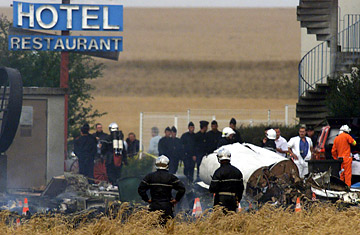
French rescuers inspect the wreckage of an Air France Concorde on July 25, 2000, after the plane crashed near Paris' Roissy airport
You might think passengers taking off or landing at Charles de Gaulle Airport would feel unsettled seeing a supersonic Concorde jet mounted on a steel frame alongside the runway, with its needle-like beak pointed upward in take-off position. After all, just such a Concorde plane crashed in a ball of fire nearly 10 years ago, less than two miles (3 km) from where the mounted jet now stands. It was an event that doomed the world's fastest-ever passenger jet — an aircraft designed by French and British engineers — to a future as a museum relic.
The French, however, do not quite feel humiliated. Wronged, perhaps, but not humiliated. In a trial that opens outside Paris on Tuesday, French officials will try to pin the blame for the Concorde's demise on Continental Airlines. It was not, they insist, the Concorde's design that led to its demise; indeed the plane still has cherished status among many in France as a feat of engineering and aesthetics, hence the monument at Charles de Gaulle.
Continental and two former employees are on trial for involuntary manslaughter, for having allowed a piece of titanium known as a wear strip to drop off one of the airline's DC-10 planes as it taxied down the runway two aircraft ahead of the fateful Air France Concorde, on a hot July afternoon in 2000. Five minutes later, the Concorde, according to the charges, rolled over the debris, which pierced one of its tires, sending pieces of rubber flying. One piece of rubber apparently penetrated the Concorde's full fuel tank, which exploded in fire. As traffic controllers screamed "You have flames! You have flames!" to the pilots, the blazing Concorde plummeted into a hotel, killing all 109 people on board and four on the ground.
Nearly a decade on, the crash remains a discomfiting subject in France, where fondness for the Concorde has never flagged. Its flight time from Paris to New York City of just 3½ hours remains about half that of any other aircraft. British Airways and Air France finally scrapped their Concorde flights in 2003, after crash investigators raised questions about potential hazards in the Concorde's design and maintenance, just as the airlines were recovering from a post-9/11 slump in business.
Investigators have also raised other concerns: the doomed Concorde appeared to be overloaded with luggage from its planeload of German tourists, who were flying to meet their cruise liner in New York City; one of two routine daily runway sweeps at Charles de Gaulle Airport had reportedly been cancelled that day; and Concorde workers had allegedly neglected to replace a crucial tire spacer on the aircraft in maintenance work four days before the crash. Continental is the only company charged, along with the firm's former welder John Taylor, who fixed the titanium strip to the Continental DC-10, and his supervisor Stanley Ford. The French are also going after their own. In the same trial, Concorde's former head of testing Henri Perrier and former chief engineer Jacques Herubel as well as France's retired civil aviation chief Claude Frantzen are also charged with involuntary manslaughter for having failed to detect and fix faults in the aircraft that investigators believe contributed to the crash. If found guilty, the individuals may face prison terms of up to three years plus fines of about $71,000 each. Continental faces a fine of as much as $520,000.
So has France unfairly fingered a U.S. company in order to protect the Concorde's legacy? In late January, a documentary on the French network Canal+ argued that point. In the film, several eyewitnesses say they remembered seeing flames coming from the plane on the runway before it hit Continental's stray metal piece, suggesting that something was wrong with the Concorde itself. That is a key point in the defense strategy pursued by Continental's lawyers, who say they have 28 witnesses who can provide similar testimony. The lawyers told the Parisien newspaper last Friday that they intend to ask the judge to dismiss the charges when the trial opens.
Air France lawyer Fernand Garnault told TIME last week he is convinced Continental is solely to blame for the crash. "It is clear that a piece from a Continental plane fell on the runway. It is clear that the origin of the accident was this," says Garnault, one of France's leading aviation lawyers. "This is my personal conviction and of course that of Air France."
Leaving aside the airlines' reputations, however, there is another question at stake in the Concorde trial: Should companies even face criminal charges after their planes crash? Several U.S. safety officials say prosecuting and jailing airline employees could make them too afraid to report maintenance or design flaws, for fear that they might be blamed later for accidents. "If airlines were protected from criminal prosecution, those fears would dissipate," says Michael Barr, an aviation-accident specialist and instructor at the University of Southern California. "You have a whole lot of people who believe that accidents are just that — accidents," he says. That is a difficult argument to make when planes crash, however. "This is a really emotional issue," he says. "When loved ones die, they want to know why. It does not matter if it was a human error."
